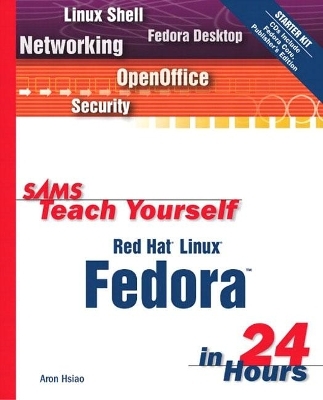
Sams Teach Yourself Red Hat Linux Fedora in 24 Hours
Sams Publishing
978-0-672-32630-1 (ISBN)
- Titel ist leider vergriffen;
keine Neuauflage - Artikel merken
Linux is an operating system, based on Unix that has become a viable desktop system for many users, especially those involved with system and network administration. Red Hat Linux has remained a leading choice of Linux distributions for years, owning more than 85 percent of the U.S. Linux market. This book covers all the most important topics for the reader who wants to get Red Hat Linux up and running and to become productive with the operating system as quickly as possible.
Aron Hsiao is a longtime Unix and Linux enthusiast with 15 years of experience administering Unix-like operating systems. Over the years, he has worked in network deployment, software development, Web development, and Internet advertising. He has also worked as a volunteer in a number of computer-related capacities in his community and served as the About.com guide to Linux for several years. He holds a degree in English and Anthropology from the University of Utah, but finds his technology skills to be more marketable. He is also the author of The Concise Guide to XFree86 for Linux and Sams Teach Yourself Linux Security Basics in 24 Hours.
(NOTE: Each chapter concludes with a Summary. Q&A. and Workshop.)
Introduction.
I. INSTALLING FEDORA.
Hour 1. Preparing to Install Fedora.
Taking a Hardware Inventory. Evaluating Your Hardware. Making Space for Linux. Launching the Fedora Installer.
Hour 2. Installing Fedora.
Starting the Fedora Installer. Beginning the Installation.
Hour 3. Booting, Logging In, and Configuring.
Booting Fedora. Welcome to Fedora Core! Configuring Your Printer and Internet Service.
II. USING LINUX AT THE CONSOLE.
Hour 4. Navigating Linux at the Console.
Why Learn to Use Linux at the Console? Understanding Virtual Consoles. Introducing the Shell. Working with the File System. Understanding Permissions.
Hour 5. Making the Console Work for You.
Creating, Editing, and Saving Text Files. Grouping Files for Efficient File Management. Searching Files and Directories Quickly. Using Command Output for Complex Tasks. Keeping Your Shell Programs Under Control.
Hour 6. Getting Help at the Console.
Introducing Manual Pages. Using the GNU info System. Using the /usr/share/doc Tree. Getting Help from the Commands.
Hour 7. Working Without the Mouse.
Printing at the Command Line. Creating High-Quality Documents at the Command Line. Performing Math Tasks Using the Binary Calculator. Creating and Sorting Lists of Data.
Hour 8. Networking Without Graphics.
Browsing the Web at the Console. Managing Email at the Console. Logging In to a Remote Linux or Unix System. Exchanging Files with Linux/Unix Hosts Using ftp. Exchanging Files with Windows Hosts Using smbclient.
Hour 9. Harnessing the Power of the Shell.
Adding to Your Command Repertoire. Using Shell Variables and Quoting. Creating Your Own Commands Using Shell Scripting.
III. USING LINUX ON THE DESKTOP.
Hour 10. Introducing the Fedora Desktop.
Notes on GNOME and KDE in Fedora. Logging In to the Desktop. Navigating the Desktop. Working with Multiple Windows. Understanding Virtual Workspaces. Logging Out of the GNOME Desktop.
Hour 11. Working with Files on the Desktop.
Creating a New Text File Using the Text Editor. Using the File Manager. Working with Files and Directories. Manipulating Files Using Drag and Drop. Working with Trash Contents.
Hour 12. Introducing OpenOffice.
The OpenOffice Applications. Creating and Formatting an OpenOffice Writer Document. Working with OpenOffice Calc.
Hour 13. Networking on the Desktop.
Introducing Mozilla. Browsing the Web with Mozilla. Reading and Writing Email. Accessing Windows Networks. Using File Transfer Protocol on the Desktop.
Hour 14. Getting Help on the Desktop.
Using Application Help. Using Systemwide Help in GNOME and KDE. Reading Other Documentation on the Desktop.
Hour 15. Customizing the Desktop.
Using the GNOME Control Center. Using the KDE Control Center. Configuring the Desktop Taskbar.
Hour 16. Advanced Linux Desktop Use.
Introducing the Desktop Terminal Application. Using Basic X Window System Applications. Interacting with the User in Shell Scripts. Scripting the Nautilus File Manager.
Hour 17. Using Desktop Applications Remotely.
Understanding the X Window System Protocol. Networking X Using the Secure Shell. Networking X Manually. Allowing Incoming X Connections with xhost. Allowing and Starting Remote X Sessions.
IV. ADVANCED TOPICS.
Hour 18. Command-Line System Administration.
Using the su Command. Managing System Processes. Managing Running Services. Managing File Systems. Managing Accounts. Using cron to Manage Periodic Jobs. Shutting Down and Restarting.
Hour 19. Desktop System Administration.
Managing System Processes. Managing Running Services. Managing Network Interfaces. Managing Accounts. Reading System Logs. Mounting and Unmounting File Systems.
Hour 20. Security Basics.
Managing the Fedora Firewall. Understanding Advanced Permissions. Protecting the root Account. Logging Out Users Automatically.
Hour 21. Installing Software.
Installing and Removing Fedora Components. Using Third-Party Software. Using the rpm Command. Using Application Launchers.
Hour 22. Offering Network File Services.
Before You Begin. Offering Network File System Service. Offering Windows File Sharing Service.
Hour 23. Offering Web and FTP Service.
Before You Begin. Running a Web Server. Running a File Transfer Protocol Server.
Hour 24. Backups, Troubleshooting, and Rescue.
Backing Up and Restoring Your Data. Dealing with Catastrophic Failures. Recognizing Other Critical Problems.
V. APPENDIX.
Appendix A: Installer Troubleshooting.
Loading Modules at Install Time. Last Resort: Module Parameters. Using the Text Mode Installer.
Index.
| Erscheint lt. Verlag | 16.12.2003 |
|---|---|
| Reihe/Serie | Sams Teach Yourself |
| Zusatzinfo | Illustrations |
| Verlagsort | Indianapolis |
| Sprache | englisch |
| Themenwelt | Informatik ► Betriebssysteme / Server ► Unix / Linux |
| Mathematik / Informatik ► Informatik ► Web / Internet | |
| ISBN-10 | 0-672-32630-2 / 0672326302 |
| ISBN-13 | 978-0-672-32630-1 / 9780672326301 |
| Zustand | Neuware |
| Haben Sie eine Frage zum Produkt? |